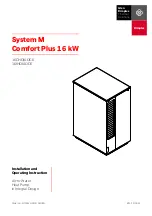
15
English
Piping instal
lation
CAUTION
•
The operating range of leaving water temperature is 15~75˚C
at heating conditions and 5~25˚C at cooling conditions.
• The minimum required water flow for operation is 7 liters/
min. At all times the required water flow-rates should remain.
Otherwise, the unit can stop due to a lack of water.
• Water quality must be according to EN directive 98/83 EC.
(Please refer to the reference guide for details.)
• Charge the water higher than pressure of 1.0 bar by using
make-up water assembly(Field supply). (The water pressure
indicated on the manometer will vary depending on the water
temperature) The nominal water pressure in the system should
remain about 1.0 bar at all times to avoid air entering the water
system.
Setting capacity and pre-pressure of the
expansion vessel
When it is required to change the default pre-pressure of
the expansion vessel(1 bar), keep in mind the following
guidelines:
f
Use only dry nitrogen to set the expansion vessel pre-
pressure.
f
Inappropriate setting of the expansion vessel pre-
pressure will lead to malfunction of the system.
Therefore, the pre-pressure should only be adjusted by
a licensed installer.
0.0
0.5
1.0
1.5
2.0
2.5
100
150
200
250
Pr
e-
Pr
es
su
re
(b
ar
)
Total water volume (
ℓ
)
Total water volume(ℓ)
Pr
e-pr
es
sur
e(bar)
Operation range
Installation
height
difference
(a)
Water volume
< 185 Litres
> 185 Litres
<7m
No pre-pressure
adjustment required.
Actions required:
• Pre-pressure must be
decreased, calculate
according to “Calculating
the pre-pressure of the
expansion vessel”.
• Check if the water volume
is lower than maximum
allowed water volume.
>7m
Actions required:
• Pre-pressure must be
increased, calculate
the appropriate
value following by
“Calculating the
pre-pressure of the
expansion vessel”.
• Check if the water
volume is lower than
maximum allowed
water volume.
Expansion vessel of the
unit too small for the
installation.
(a) Installation height difference: height difference(m) between
the highest point of the water circuit and the indoor unit. If
the unit is located at the highest point of the installation,
the installation height is considered 0m.
• When Expansion vessel has a capacity 8 liters and 1bar
pre-charged.
Water volume of total system for reliable performance
is minimum 30 Liter (AE050/080CXYD**), 50 Liter
(AE120/160CXYD**).
Calculating the pre-pressure of the expansion vessel
f
The pre-pressure(Pg) to be set depends on the maximum
installation height difference(H) and is calculated as below :
Pg=(H/10+0.3) bar
Protection of the water circuit freezing
To prevent the hydraulic components from freezing, it has a
freezing protection function that includes activation of the pump
at low temperatures.
However, in case of a power failure, these functions cannot
guarantee protection.
To protect the water circuit from freezing, any one of the following
acts shall be performed.
• Add glycol to water. Glycol lowers the freezing point of water.
• Install the anti-freeze valve. The anti-freeze valve discharges
water from the system before it freezes.
Freeze protection by glycol
Freeze protection solutions must use propylene glycol with
a toxicity rating of Class 1 as listed in Clinical Toxicology of
Commercial Products, 5th Edition.
WARNING
• Ethylene glycol is toxic and must not be used in the primary
water circuit in case of any cross-contamination of the portable
circuit.
• If you add glycol to the water, do NOT install anti-freeze valve,
to avoid Glycol leaking out of the anti-freeze valves into the
environment.
• If an anti-freeze protection is used, it will result in increased
pressure drop and it may also cause a slight capacity reduction.
CAUTION
• Due to the presence of glycol, corrosion of the system is
possible. Uninhibited glycol will turn acidic under the influence
of oxygen. The acidic uninhibited glycol attacks metal surfaces
and forms galvanic corrosion cells that cause severe damage
to the system.
• A glycol with corrosion inhibitors is selected to counteract
acids formed by the oxidation of glycols.
• No automotive glycol is used because their corrosion inhibitors
have a limited lifetime and contain silicates which can foul or
plug the system.
• Galvanized pipes are NOT used in glycol systems since the
presence may lead to the precipitation of certain components
in the glycol’s corrosion inhibitor.
Summary of Contents for AE CXYD Series
Page 29: ......
















































